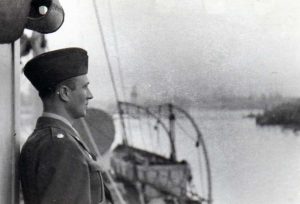
Lt. Col. E. Rusteberg – West Point 1934 – Two Silver Stars, One Bronze Star, Presidential Unit Citation (Battle of Hatten), Purple Heart.
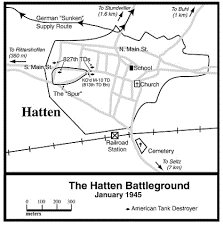
The Battle of Hatten
The battalion began the battle of Hatten with 33 officers and 748 en- listed men. Fifty-two hours later it had an effective strength of 11 officers and 253 enlisted men. All others were either killed, wounded or missing in action.
PRESIDENTIAL CITATION:
The President of the United States of America, authorized by Act of Congress July 9, 1918, takes pleasure in presenting the Silver Star to Lieutenant Colonel (Infantry) Edwin Rusteberg (ASN: 0-19542), United States Army, for gallantry in action while serving with Headquarters, 1st Battalion, 242d Infantry Regiment, 42d Infantry Division, in action on 9 January 1945 at Hatten, France.
As Commanding Officer of the First Battalion, 242d Infantry Regiment, during the action at Hatten, France, Colonel Rusteberg planned and executed the defense of that area with outstanding success.
In spite of point blank fire from enemy tanks supported by Infantry that raked his positions with fire, Colonel Rusteberg by personal example held his troops in position and withstood the enemy attack.
Fighting side by side with his men in the face of overwhelming odds without mechanized or artillery support, Colonel Rusteberg by his courageous leadership, tenacity and devotion to duty played a major role in the successful defense of the town of Hatten.
General Orders: Headquarters, 42d Infantry Division, General Orders No. 131 (1945)
Action Date: 9-Jan-45 Service: Army Rank: Lieutenant Colonel Company: Headquarters Battalion: 1st Battalion Regiment: 242d Infantry Regiment Division: 42d Infantry Division. (Entered military service from Brownsville, Texas).
*******************************************************
A Kraut’s Dilemma in Combat
(This article was written many years after the Battle of Hatten as part of a series of letters written to his two children about his life’s experiences spanning from childhood to shortly before his death in 1990 – Bill Rusteberg)
By Col. E. Rusteberg
At the time of the Battle of the Bulge in WWII, my unit was in charge of the defense of a small village in Alsace.
During one of the numerous enemy attacks against this village, a German tank, supported by a squad of infantry, attacked the building in which some of my troops and I were located.
The tank was promptly destroyed by a bazooka round from the attic of the building and its burning and exploding hulk created an inferno in the center of the street to our front.
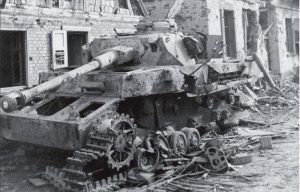 The supporting infantrymen, about ten in number, were simultaneously mowed down by a machine gun in the building and lay scattered in the street about fifty yards in front of us. All appeared to be dead as none moved.
The supporting infantrymen, about ten in number, were simultaneously mowed down by a machine gun in the building and lay scattered in the street about fifty yards in front of us. All appeared to be dead as none moved.
After about a half hour, one of these “apparently dead” German soldiers came to and sat up in the middle of the street facing in our direction. As he sat there in this ” no mans land”, all alone, he decided to take inventory of his wounds. As we watched him examine the various parts of his body we could see that he had been hit in both legs and one arm.
We all watched him, wondering what he would do in this terrible predicament in which renewed fighting was expected momentarily. His thinking was not hard to decipher as first he looked around him and saw all his comrades lying dead nearby and his supporting tank, with its cremated crew, still smouldering from its violent end.
“I’m the sole survivor and badly wounded”, he must have said to himself, as he used his good arm to feel the extent of the damage to his extremities, “and here I am in the middle of this bare street, half way between friend and foe!”
He knew he couldn’t stay where he was or surely he would be caught in the crossfire which was expected momentarily/. So he must move the best he can to the side of the street and “out of the way.” At the same time he must be very careful not to give the enemy the impression that he was making an “offensive” move or he might be picked off by some “trigger happy” American G.I.
So he moved very slowly, the best he could, by remaining sitting, facing us, and by the use of his good arm slid himself an inch at a time until finally, hours later, he reached the edge of the street and could lean back and rest his body against the corner of a brick building.
There he sat in this new position for some time, with a seat on the “fifty yard line, waiting for the “kickoff” of the next contest. But since all was quiet at the moment, and he was hungry and needed something to do to divert his mind, he reached into his pocket and pulled out an apple. There in front of “God” and all to see, he nonchallantly proceeded to eat the whole apple, as friend and foe alike watched the apple disappear bite by bite as time passed slowly by.
As darkness fell, and as we awaited the night attack which was to come, we bid our lonely foe, in his terrible dilemma, “Gods’s Speed, Brave Kommarade!!!”
***********************************************************
The Hero at the Battle of Hatten was Vito Bertoldo. I tracked down his son several years ago who lives in California. He served two tours in Vietnam as a Marine. He is a retired California State Highway patrolman – Bill Rusteberg
The CONGRESSIONAL MEDAL OF HONOR is awarded to VITO R. BERTOLDO, Master Sergeant [then Private First Class] Infantry, Company A, 242D Infantry Regiment, for conspicuous gallantry and intrepidity at the risk of his life above and beyond the call of duty at Hatten, France, 9-10 January 1945.
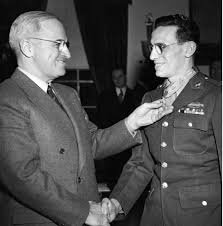 Master Sergeant Bertoldo fought with extreme gallantry while guarding 2 command posts against the assault of powerful infantry and armored forces which had overrun the battalion‘s main line of resistance.
Master Sergeant Bertoldo fought with extreme gallantry while guarding 2 command posts against the assault of powerful infantry and armored forces which had overrun the battalion‘s main line of resistance.
On the close approach of enemy soldiers, he left the protection of the building he defended and set up his gun in the street, there to remain for almost 12 hours driving back attacks while in full view of his adversaries and completely exposed to 88-mm., machinegun and small-arms fire.
He moved back inside the command post, strapped his machine-gun to a table and covered the main approach to the building by firing through a window, remaining steadfast even in the face of 88-mm.fire from tanks only 75 yards away.
One shell blasted him across the room, but he returned to his weapon. When 2 enemy personnel carriers led by a tank moved toward his position, he calmly waited for the troops to dismount and then, with the tank firing directly at him, leaned out of the window and mowed down the entire group of more than 20 Germans.
Some time later, removal of the command post to another building was ordered. M/Sgt. Bertoldo voluntarily remained behind, covering the withdrawal of his comrades and maintaining his stand all night.
In the morning he carried his machine-gun to an adjacent building used as a command post of another battalion and began a day-long defense of that position.
He broke up a heavy attack, launched by a self-propelled 88-mm. gun covered by a tank and about 15 infantrymen. Soon afterward another 88-mm. weapon moved up to within a few feet of his position, and, placing the muzzle of its gun almost inside the building, fired into the room, knocking him down and seriously wounding others.
An American bazooka team set the German weapon afire, and M/Sgt. Bertoldo went back to his machine-gun dazed as he was and killed several of the hostile troops as they attempted to withdraw.
It was decided to evacuate the command post under the cover of darkness, but before the plan could be put into operation the enemy began an intensive assault supported by fire from their tanks and heavy guns.
Disregarding the devastating barrage, he remained at his post and hurled white phosphorous grenades into the advancing enemy troops until they broke and retreated.
A tank less than 50 yards away fired at his stronghold, destroyed the machine-gun and blew him across the room again but he once more returned to the bitter fight and, with a rifle, single-handedly covered the withdrawal of his fellow soldiers when the post was finally abandoned.
With inspiring bravery and intrepidity M/Sgt. Bertoldo withstood the attack of vastly superior forces for more than 48 hours without rest or relief, time after time escaping death only by the slightest margin while killing at least 40 hostile soldiers and wounding many more during his grim battle against the enemy hordes.
In the face of direct fire from a Mark V tank, Pvt. Vito Bertoldo stayed at his post and continued to fire. His assistant gunner, Pvt. John Grabos of “C” Co. was severely wounded.
[The Rainbow Battle Deaths WWII booklet lists PFC John A. Grabos, 35 840 040, Co. “C”, 1st Bn., 242D Inf. Regt. as having died of wounds on 01/21/45. Entered military service from Gary, Indiana]
*******************************************************
Col. Rusteberg, years after his retirement from the Army, related a story about Vito. On the voyage across the Atlantic to North Africa, word came up from the ranks that one of the cooks, Vito Bertoldo, wanted to become a rifleman. Seems he was not getting along with his fellow cooks and wanted a transfer. Request granted. Little did Vito’s superiors know that Vito would go on to win the Congressional Medal of Honor during the Battle of the Bulge.
********************************************************
Footnote:
A German NCO who was captured praised the soldiers for their gallant stand:
“We were amazed at the way your men fought. We always considered you could defeat us only if you had a tremendous amount of tanks and armor. We believed that if we met you on equal terms we would have no difficulty. At Hatten we had the armor and the artillery and the experienced men. Your men were inexperienced and lacked tanks and artillery support. Our officers said it was the best infantry defense they ever saw.”
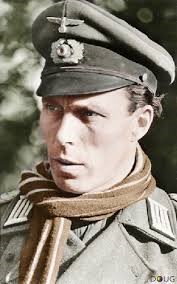 One interesting comment is by a very experienced German officer, Col. Hans Von Luck, who fought with the German army on every front from Poland in 1939 to the Russian victory over the Germans in 1945.
One interesting comment is by a very experienced German officer, Col. Hans Von Luck, who fought with the German army on every front from Poland in 1939 to the Russian victory over the Germans in 1945.
Von Luck commanded one of the tank units attacking Hatten and the nearby village of Rittershofen.
In a book describing his World War II experiences he writes: “In those two villages, Hatten and Rittershofen, there now developed one of the hardest and most costly battles that ever raged on the Western front.”

